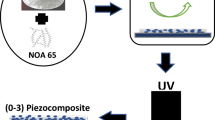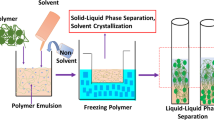Abstract
The paper studies the possibility of changing the properties of piezoceramic materials of various functional groups. The aim of this work was to vary the properties of piezoceramics at the stage of production by changing the technological factors with a constant chemical composition. The microstructure of piezoceramics is formed during its sintering, and also are the most important mechanical properties – density and hardness – which affect electrophysical properties. Therefore, by correcting the microstructure formation process, it is possible to change the electrophysical properties of piezoceramics. Methods of hot pressing and spark plasma sintering allow us to effectively correct the forming process of the sintered piezoceramics microstructure. The aim of this study was to use these methods for the sintering of piezoceramic materials of various functional groups and variations of their parameters. The study confirmed the effectiveness of the proposed methods for a wide-range changing piezoceramic functional parameters.
Similar content being viewed by others
Avoid common mistakes on your manuscript.
INTRODUCTION
Piezoelectric ceramics of the lead zirconate titanate (PZT) system provided a basis for a majority of piezoceramic materials with a wide range of usage [1–2]. As the practical use increased, chemical composition of piezoceramics was modified and upgraded to the multi-component systems in order to achieve required electrophysical properties [2–4]. Apart from the PZT piezoceramic materials, piezoelectric compositions based on BaTiO3, PbTiO3, Pb(Mg1/3Nb2/3)O3 and (Na, K)NbO3 became widespread [2, 5].
There is also an opportunity of changing electrophysical parameters of piezoceramics by correcting technological factors at production stage. Mechanical properties (microstructure, density, solidity and strength) develop at the piezoceramics sintering stage [2]. Therefore, sintering conditions influence future electrophysical parameters of piezoceramics, since piezoelectric effect is a phenomenon of electromechanical conversion. Methods of consolidation sintering (hot pressing (HP) and spark plasma sintering (SPS)) are of particular interest, since they allow significant correction of piezoceramics microstructure.
Ferroceramics of the barium-strontium titanate system, which is active in a range of super high-frequency (SHF) regimes of 0.7–30 GHz, has displaced traditional semiconductor and ferrite devices as switching and controlling elements of technical devices.
Use of the Ba0.55Sr0.45TiO3 (BST) ferroceramics in acceleration techniques requires a significant reduction in hysteresis phenomena and a decrease in dielectric loss (tan δ). Such problem might be solved by the introduction of impurities (Mg, Mn, magnesium titanate, etc.) to the basic composition [6–7] and by different ways of sintering: traditional one, in a chamber kiln (ATM), and also via spark plasma sintering (SPS).
BST ferroceramics with an 80% addition of Mg obtained via SPS is characterized by 40% lower dielectric loss (tan δ) and 50% lower dielectric permittivity (εТ33/ε0) in comparison to ferroceramics obtained at ATM (Table). Such changes positively influence the effectiveness of SHF devices [7]. BST ferroceramics obtained via the hot-pressing method had lower values of tan δ and εТ33/ε0 and also an increased experimental density in comparison to the ATM method. However, HP ceramics are less effective in the SPH devices than the ones made via SPS. Microstructure of the BST ceramics obtained by all discussed methods had similar properties (Figs. 1, a1–a3), although grain size was higher in the case of HP (Fig. 1, a2).
Besides traditional PZT piezoelectric materials, soft ferroelectric piezomaterials of the (1–х)Pb(Mg1/3Nb2/3)O3– хPbTiO3 (PMN-PT) system, that are characterized by the increased electrophysical properties, are more widely used. Piezoceramics based on PNM-PT are used in multi-layered condensers with increased values of dielectric permittivity, actuators, micromanipulators and also high-frequency convertors. However, there occur problems during production of piezomaterials of such system (formation of pyrochlore crystalline structure during the material synthesis, etc). In order to minimize stated problems and also to improve mechanical and electrophysical characteristics, sintering of PMN-PT piezomaterials by HP and SPS methods was fulfilled (Table 1).
PMN-PT piezoceramic elements, sintered via SPS, had values of electrophysical parameters increased by 9% in comparison with ATM items. Increased parameters might be explained by the formation of a flawless monodisperse structure of ceramics obtained via SPS (Fig. 1, b3). Sintering of PMN-PT piezoceramics via HP also ensures an increase of the d33 piezoelectric module values by 8% in comparison with the ATM sintering [8] with the similar type of microstructure (Figs. 1, b1–b2).
Ferroelectrically hard piezoceramic materials are used in manufacturing of high-power ultrasonic devices, piezo transformers and piezo transducers active in emission mode [9]. As a research object, a multi-component ferroelectrically hard composition PbZrO3–PbTiO3–Pb(Mn1/3Nb2/3)O3–Pb(Zn1/3Nb2/3)O3 was taken.
Ferroelectrically hard piezoceramic elements sintered via HP and SPS methods are characterized by increased values of dielectric permittivity εТ33/ε0 by 8 and 16 %, respectively, in comparison with values of elements obtained via AMP [10]. Optimal sintering temperature of ferroelectrically hard piezoceramics via SPS occurred to be 200°С lower than via ATM (Table 1). Microstructure of piezoceramics obtained via SPS differed in the packing density of grains and the absence of pores (Fig. 1, c3). There was a significant amount of glass phase together with the poreless grain packing in microstructure of piezoceramics obtained via HP in comparison with the ATM ceramics (Figs. 1, c2 and c1, respectively).
Multi-component piezoceramic systems with increased electrophysical characteristics used in manufacturing of multi-layer actuators with the low actuation voltage are of huge practical interest. Manufacturing of such actuators requires correspondence of ceramic layer sintering temperatures with the burning-in temperature of the interlayer electric conductors. As a model object, a multi-component ferroelectrically soft piezomaterial PbTiO3–PbZrO3–Pb(Ni1/2W1/2)O3–Pb(Cd1/2W1/2)O3– Pb(Bi2/3W1/3)O3–Pb(Ni1/3Nb2/3)O3–Pb(Zn1/3Nb2/3)O3 with a sintering temperature lower than 1000°С was selected. Microstructure of multi-component piezoceramics obtained via ATM, HP, and SPS validates the possibility to control the fine-grain ceramic structure formation (Figs. 1, d1–d3). Solid ceramic structure forms already at 850°С.
As a result of this study, SPS was discovered to be the preferable method of piezoceramic sintering. Such method allows lowering sintering temperature of ceramic items to 900°С, so all the main properties of piezoelectric ceramics will remain in comparison with ATM [11]. However, maximal properties of piezoceramics obtained via SPS are acquired at 980°С (Table 1).
CONCLUSIONS
Sintering of piezoelectric ceramics via HP and SPS methods leads to the formation of a dense, defectless microstructure which provides an increase in the main electrophysical and mechanical characteristics. Moreover, HP and SPS methods allows to execute ceramic sintering processes at lower temperatures.
The SPS method is especially noteworthy, since it exhibits huge potential in the targeted formation of required microstructure and, therefore, of piezoceramic properties. Besides, the SPS method not only promotes a decrease in sintering temperatures by 150–300°С, but also shortens time of isothermal conditioning (at 36 times!). It does not only have a positive effect on energy saving, but also increases effectiveness of piezoelectric ceramics of various functional groups.
REFERENCES
Kupriyanov, M.F., Konstantinov, G.M., and Panich, A.E., Segnetoelektricheskie morfotropnye perekhody (Ferroelectric Morphotropic Transitions), Rostov-on-Don: Rostov. Univ., 1991.
Fesenko, E.G., Dantsiger, A.Ya., and Razumovskaya, O.N., Novye p’ezokeramicheskie materialy (New Piezoceramic Materials), Rostov-on-Don: Rostov. Univ., 1983.
Topolov, V.Yu. and Panich, A.E., Elektr. Nauch. Zh. “Issledovano v Rossii”, 2008, no. 002, pp. 8–26.
Panich, A.A., Marakhovskiy, M.A., and Motin, D.V,. Inzh. Vestn. Dona, 2011, no. 1.
Keramik/Hrsq. H. Schaumburq, Stuttqart: B.G. Tenbner, 1994.
Vendik, O.G., Dedyk, A.I., Dmitrieva, R.V., Zaionchkovskii, A.Ya., Likholetov, Yu.V., and Ruban, A.S., FTT, 1984, vol. 26, no. 3, pp. 684–689.
Marakhovskiy, M.A., Panich, A.A., and Marakhovskiy, V.A., INTERMATIC-2018, Moscow, Ch. 2, 2018.
Marakhovskiy, M.A. and Panich, A.A., Izv. YuFU: Tekhnicheskie Nauki, 2017, no. 6(191), pp. 242–249.
Sharapov, V.M., Minaev, V.G., Sotula, Zh.V., and Kunitskaya, L.G., Elektroakusticheskie preobrazovateli (Electroacoustic Transducers), Moscow: Tekhnosfera, 2013.
Marahovskiy, M.A., Panich, A.E., and Marakhovskiy, V.A., Agoi, 2019.
Marakhovskiy, M.A., Marakhovskiy, V.A., Miryushchenko, E.A., and Panich, E.A., GA-2018, St. Petersburg, 2018.
Author information
Authors and Affiliations
Corresponding author
Ethics declarations
No conflict of interest was declared by the authors.
Rights and permissions
About this article
Cite this article
Marakhovskiy, M.A., Panich, A.E. & Marakhovskiy, V.A. Promising Methods for Manufacturing High-Performance Piezoelectric Transducers. Russ J Gen Chem 91, 2678–2681 (2021). https://doi.org/10.1134/S1070363221120422
Received:
Revised:
Accepted:
Published:
Issue Date:
DOI: https://doi.org/10.1134/S1070363221120422





